 |  Life-Span Development, 8/e John W. Santrock,
University of Texas - Dallas
Adolescence Physical and Cognitive Development in Adolescence
Chapter ObjectivesI.Understand the nature of adolescence including how adolescents view themselves and how others view them. |
 |  |  | II.Describe the physical, hormonal, and psychological changes that take place during puberty. |
 |  |  | III.Discuss how the timing of pubertal changes impacts females and males. |
 |  |  | IV.Elaborate on adolescent sexuality, including development of a sexual identity, progression of sexual behaviors, contraceptive use, and STDs. |
 |  |  | V.Examine adolescent pregnancy, including statistics, consequences, and ways to reduce rates. |
 |  |  | VI.Discuss substance abuse among adolescents, being certain to identify which drugs are on the rise and which are declining in use. |
 |  |  | VII.Address the rates and effects of alcohol and nicotine use among teens. |
 |  |  | VIII.Identify the role development, parents, and peers play in the decision to partake in alcohol, drug, and nicotine use. |
 |  |  | IX.Differentiate between anorexia nervosa and bulimia nervosa. |
 |  |  | X.Describe adolescent health and the leading causes of death in adolescence. |
 |  |  | XI.Discuss Piaget's stage of formal operational thought. |
 |  |  | XII.Define adolescent egocentrism and distinguish between Elkind's two types of social thinking. |
 |  |  | XIII.Elaborate on how decision making and critical thinking change during adolescence. |
 |  |  | XIV.Examine the transition from elementary school to junior high school, including the criteria of an effective school. |
 |  |  | XV.Address the rate, causes, and effects of high school dropouts. |
 |  |  | XVI.Discuss how schools in the United States differ from schools in other countries. |
 |  |  | XVII.Discuss programs and services designed to teach moral education. |
|



 2002 McGraw-Hill Higher Education
2002 McGraw-Hill Higher Education